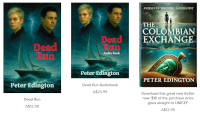Peter Edington
Author, Activist, Yachtsman
• Author
• Activist
• Yachtsman

Help me raise 10,000 for UNICEF
Every time a copy of my new thriller "The Colombian Exchange" is downloaded, $10 of the purchase price goes directly to UNICEF
UNICEF provide shelter, food and education for children caught up in war, drought and famine.



Born in Aberdeen, Scotland, Peter has sailed some 70,000 ocean miles, including three Atlantic crossings, one trans-Pacific, eight Tasman/Coral Sea crossings and a voyage from the UK to Australia.
As a result of visiting Africa and many Island nations during his voyages, Peter became concerned with world poverty. Since then, he has taken cataract replacement equipment 200 miles up West Africa's Gambia River for Sightsavers International and has made his ocean-going yacht available for promoting such organisations as The Fred Hollows Foundation and youth poverty-action group The Oaktree Foundation.
He is also very concerned that more awareness is needed for the dire consequences of Climate Change and the dangers of ignoring it.
If you would like to know more about The Colombian Exchange, do email me at PeterEdington_Author@proton.me.
